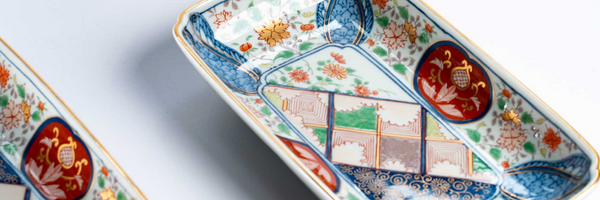Kutani ware, originating from the esteemed Kaga region nestled within Ishikawa Prefecture, boasts a heritage spanning more than three and a half centuries. Its hallmark lies in the resplendent fusion of five vibrant hues: green, yellow, red, purple, and navy blue, expertly applied to accentuate its audacious contours. Across generations, its evolution has been propelled by the relentless dedication and passion of artisans, who strive for both innovation and preservation of tradition.
Renowned globally as "Japan Kutani," its allure transcends borders, celebrated for the myriad styles and painting techniques that adorn its surfaces, a testament to its enduring beauty and craftsmanship.

Kutani ware is characterized by its colorful overglaze called "Gosai (five-colored)." The brilliant overglaze painting is unique to each kiln, and every kiln has its own unique style of painting. The clay used for Kutani ware is both ceramic and porcelain, each with its own unique qualities, and both offer vivid colors.
Although its production once ceased in the start of the 18th century, Kutani ware was revived 100 years later and once again thrived as a craft as multiple kilns opened and specialized in generating their own unique styles. During the Meiji Period (1868-1912), the technique of applying gold patterns called "Kinrande," in addition to the five colors of painting, was developed and attracted worldwide attention under the name of "Japan Kutani." Kutani ware continues to evolve while keeping in touch with its traditional roots.
How is Kutani Made?
Kutani begins its journey with the extraction of pristine white China clay sourced from Komatsu. Crafted by the skilled hands of the potter, the clay takes shape before undergoing its initial firing. Subsequently, an underglaze is delicately brushed onto the piece, followed by a coat of white glaze, imbuing it with a luminous, glass-like quality upon firing. This white glaze not only enhances its aesthetic appeal but also reinforces the porcelain's structure. A second firing completes this stage of the process.

In the quintessential Kutani fashion, post the second firing, the piece comes to life as colorful overglaze is meticulously applied. Through another round of firing, the vibrant hues meld with the glaze, creating a captivating interplay of colors.
Following this phase, the piece awaits the adornment of gold or silver leaf. Once the precious metal leaf is carefully applied and the final glaze is sealed, the piece undergoes its ultimate firing, culminating in its transformation into a masterpiece of Kutani ware.
How to Identify Kutani Ware?
Various styles of Kutani ware exhibit distinct characteristics and artistic nuances.
Traditionally, Kutani pottery is celebrated for its delicate porcelain construction and adorned with a vibrant palette of yellow, green, purple, red, and Prussian blue glazes. Among the myriad styles, some of the most notable include:
Aote:
This style, pioneered by the Yoshidaya Kiln, features a refined selection of four colors. Notably, red is omitted, allowing Prussian blue to emerge as the dominant hue, lending a striking contrast to the piece.
Iroe:
Renowned for its exuberant color palette, Iroe stands as the epitome of Kutani's vibrancy. Incorporating all five colors—yellow, green, red, purple, and Prussian blue—this style captivates with its kaleidoscopic richness.
Embodying the essence of Kutani craftsmanship, each piece bears the distinctive Kutani signature, often meticulously painted onto the underside, serving as a testament to its heritage and artistry.

